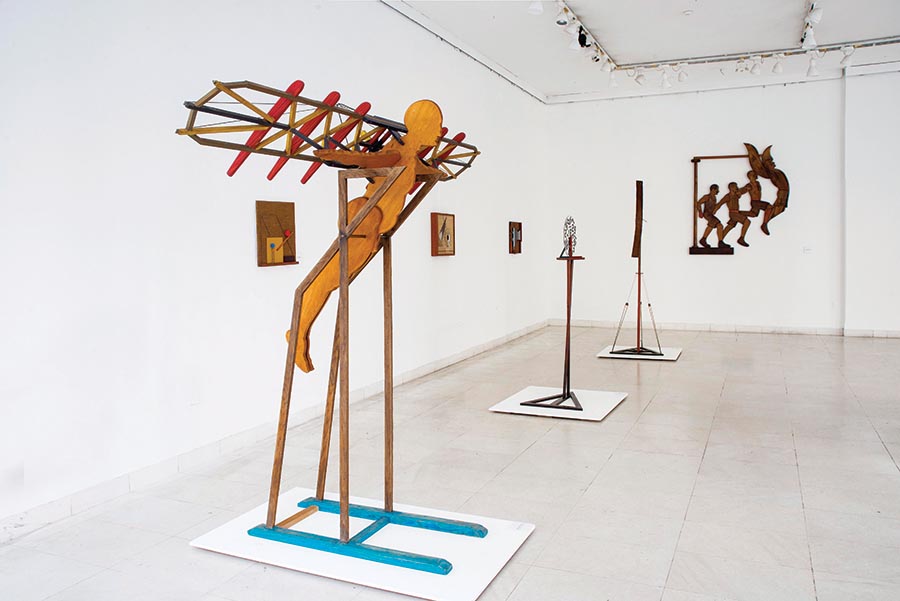Between 16 June and 26 August 2016, the Museum of Contemporary Art of the Republic of Srpska will host the exhibition“Ilija Dimić – An Exhibition of Paintings and Structures” by artist and SANU member Dušan Otašević.
This will be an opportunity for Banja Luka’s museum-goers to learn about the unique concept behind the name of Ilija Dimić, “an imaginary genius and ideal artist,” whose eventful biography is a joint brainchild of Dušan Otašević and Branko Vučićević, a renowned film theorist, critic and playwright from Belgrade.
“I never had a spiritual father from the history of art, so I decided to make one up!” said Dušan Otašević, presenting the works of Ilija Dimić, his fictional “ancestor.”
Otašević’s exhibition“Ilija Dimić – An Exhibition of Paintings and Structures,” which was awarded by the Ivan Tabaković Foundation, was originally staged at Belgrade’s Sebastian Gallery in 1990. It was the first time this fantastic simulation – the oeuvre of Ilija Dimić, a previously unheard-of pilot and avant-garde artist – was publicly shown. The timeline of the life of Ilija Dimić begins in 1901, when he was born in Belgrade, and finishes in 1938, when he died as a volunteer in the Spanish Civil War. He was trained at Bauhaus; he was thrilled by Dadaism, Zenitism, Russian Constructivism; he kept up a correspondence with Tatlin; he was obsessed with flying, and Daedalus was his role model. It was in the same spirit that Ilija made his aerodynamic works, which Otašević patinated to make them look as authentic as possible.
Art historian Ješa Denegri points out that the nature of the exhibition is dual; it is jovial and accessible, on the one hand, but it also poses some of the fundamental questions asked by art historians. Among other things, this fictional simulation problematises authorship, the originality and reproduction of works of art, and the paradoxes of reconstruction of fictitious events, or the issue of whether what the history of art really does is deconstruct or reconstruct art.
The exhibition was organised in association with the Gallery of the Serbian Academy of Sciences and Arts and the collection of the Trajković Foundation from Belgrade.
Dušan Otašević (Belgrade, 1940)
Dušan Otašević graduated from the Academy of Fine Arts in 1966, the class of Professor Ljubica Cuca Sokić. He is/was one of the former Yugoslavia’s most influential pop artists. If compared to the other artists of the Belgrade art scene back in the 1960’s, Dušan Otašević took the most radical turn toward using everyday consumer goods as data, symbols and themes. As Otašević’s activities coincided with the emergence of pop art in the United States, his focus shifted the most typical objects found in the consumer society, which expectedly led to his creating a new figurative and object iconography.
Otašević broke with the traditional painting approach, with the result of his works no longer corresponding to what painting had until then meant in a technical sense, but rather becoming objects or newly made items, paintings-objects. Most often, these paintings-objects were created segment after segment, or as polyptychs (work construction), and were metaphorically enhanced by means of polysemous titles or names, which then became understood as “works with messages,” and not simply as works that sufficed owning merely to their visual presentational quality. Otašević increasingly insisted on the contents of works, bringing a foretaste of his future inclination to fictional stories, which culminated with a series about the (fictional) Tronoša rules of icon painting and a “reconstruction” of objects made by the non-existent artist Ilija Dimić. In his works Otašević demystifies the notion of art and the idea of the artist as someone who “creates” under the lucky star of inspiration (“No mystery, no muse” – D. O.)
At the very start of his career, in the 1960s and the 1970s, Otašević enjoyed the support of Belgrade proponents of New Figuration and the young generation of critics. He had several solo exhibitions in Belgrade, followed by numerous shows abroad, of which his participation in the 36th Venice Biennale in 1972 is particularly worth mentioning. He has had over fifty solo exhibitions and participated in more than a hundred and fifty collaborative exhibitions, both in Yugoslavia/Serbia and abroad. He has been a member of ULUS since 1967. Between 2000 and 2006, he worked as a lecturer at the Academy of Fine Arts in Belgrade. In 2003, he became a corresponding member of the Serbian Academy of Sciences and Arts, and since 2009, he has been its full member. Since 2011, he has been the manager of the Gallery of the Serbian Academy of Sciences and Arts. He has won a number of awards and recognitions.
The significance and contemporary relevance of Otašević’s work has once again been proven by his exhibiting in “The World Goes Pop” at London’s Tate Modern, which lasted between September 2015 and January 2016.
-
 Title
Title
Title
Title
-
 Title
Title
Title
Title
-
 Title
Title
Title
Title
-
 Title
Title
Title
Title
-
 Title
Title
Title
Title
-
 Title
Title
Title
Title
-
 Title
Title
Title
Title
-
 Title
Title
Title
Title
-
 Title
Title
Title
Title
http://msurs.net/index.php/en/izlozbe-6/arhivaizlozbe/izl2016-6/574-k-14-30a-2a-2as#sigProIdaa4fc039e9

